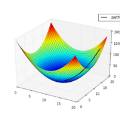Recent developments in surrogate construction predominantly focused on two strategies to improve surrogate accuracy. Firstly, component-wise domain scaling informed by cross-validation. Secondly, regression to construct response surfaces using additional information in the form of additional function-values sampled from multi-fidelity models and gradients. Component-wise domain scaling reliably improves the surrogate quality at low dimensions but has been shown to suffer from high computational costs for higher dimensional problems. The second strategy, adding gradients to train surrogates, typically results in regression surrogates. Counter-intuitively, these gradient-enhanced regression-based surrogates do not exhibit improved accuracy compared to surrogates only interpolating function values. This study empirically establishes three main findings. Firstly, constructing the surrogate in poorly scaled domains is the predominant cause of deteriorating response surfaces when regressing with additional gradient information. Secondly, surrogate accuracy improves if the surrogates are constructed in a fully transformed domain, by scaling and rotating the original domain, not just simply scaling the domain. The domain transformation scheme should be based on the local curvature of the approximation surface and not its global curvature. Thirdly, the main benefit of gradient information is to efficiently determine the (near) optimal domain in which to construct the surrogate. This study proposes a foundational transformation algorithm that performs near-optimal transformations for lower dimensional problems. The algorithm consistently outperforms cross-validation-based component-wise domain scaling for higher dimensional problems. A carefully selected test problem set that varies between 2 and 16-dimensional problems is used to clearly demonstrate the three main findings of this study.
翻译:翻译后的摘要:
近年来,代理构建的发展主要集中在两种策略上,以提高代理的准确性。其一,是基于交叉验证的逐分量域缩放方法,其可靠地提高了低维度的代理质量,但在高维度问题上的计算成本高。其二,是利用额外的函数值和梯度等多样本数据来构建响应曲面的回归方法。直观上,这些增强梯度的回归模型并不能比仅使用函数值进行插值的模型表现更好。本研究基于具体实验结果,发现了三个主要的发现。首先,当使用附加梯度信息进行回归时,如果在不正确缩放的域中构建代理,这是导致响应曲面恶化的主要原因。其次,代理准确性会提高,当在全新的缩放旋转后的域中构建代理,这个方案不仅能简单进行域缩放。域转化方案应该基于逼近曲面的局部曲率,而不是全局曲率。第三,梯度信息的主要优势,是能够高效地确定构建代理的(近乎)最优域。本研究提出了一种基础的转换算法,用于低维度问题的近乎最优转换,该算法始终优于基于交叉验证的逐分量域缩放方法,在高维度问题上的表现更加优秀。我们使用经过精心筛选的测试问题集,包括2至16维的测试问题,以清楚地展示了本研究的三个主要发现。



